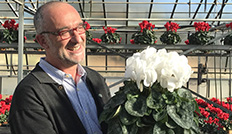 Professional area | Culture factsheet | The growing medium | The growing medium : chemical properties
Professional area | Culture factsheet | The growing medium | The growing medium : chemical properties
Those components of the medium that are not inert have a chemical effect on the nutritive solution because of electrolyte exchange.
The ideal pH of 5.6 - 5.8 is not stable during the growing season and needs to be checked periodically so as to ensure a good uptake of the nutrients and trace elements.
The medium may be more than an inert supporting substance where the nutrient solution circulates. Mineral and organic solids may be present and make a difference by governing and regulating the composition of the nutrient solution.
Mediums are characterised by their absorbent capacity or cation exchange capacity (CEC), by the major elements and trace elements that they contain, and by their acidity (pH).
Mediums can contain substances known as ‘colloids’ (clay and humus). These colloids have the ability to fix certain cations (calcium, magnesium, potassium, sodium, hydrogen) from the soil solution or nutrient solution, because of the negative charges on their surface. Some anions may also be fixed, via cations with two or three valences, though the great majority remain in solution.
The cation exchange capacity is the quantity of ions which a given quantity of medium or soil can fix. It is stable, depending only on the nature and quantity of colloids present in the medium.
In this way, ions (especially of the main elements) are either held by the substrate or in solution; and there is a dynamic equilibrium between these two. In the case of the trace elements such equilibriums exist but they are somewhat more complex.
Clay and humus compounds form a clay-humus complex on the surface of which these cations are held. Thus the mediums play their part in feeding the plants. (But when there are exchanges between the complex and the solution, this can complicate the calculation of nutrients to be supplied.)
In addition, the presence of lone protons (hydrogen ions) can make the solution acid.
The pH of mediums may vary depending on their composition. The ideal for cyclamen growing medium is between 5.6 and 5.8. When moss peat is used, the pH value will need to be raised (with the use of calcium carbonate): 2kg/c.m. of calcium carbonate are needed to raise pH by one point. Calcium carbonate allows a slow and gradual rise in pH which stabilises well thereafter.
Acidity, though, is not a stable property of the medium: it varies (according to the season, because of the plants growing), and it is better therefore to adjust its level throughout the growing cycle so as to avoid too frequent changes which could cause poor assimilation of nutrients.
Different kinds of exchange may be set up between medium and solution.
They may exchange ions (via the absorbent complex). The medium itself may be partly dissolved under the influence of the nutrient solution; this tendency is greater under acid conditions, and an active root may secrete hydrogen ions, thus making their immediate vicinity more acid (this fall in pH encourages phosphate and trace element uptake on the part of the plant).
These exchanges may result in an acidification of the solution or conversely in a raising of its pH. The content of certain ions (e.g. calcium, copper) may get so high that the plant’s tolerance threshold is exceeded. Some ions may precipitate out of solution (calcium, phosphates, sulphates) and thus become unavailable to the plant.
The medium itself has a better buffering potential, thanks to its ion exchange capacity. This potential is connected with the presence in it of colloidal substances.
Mediums based on peat and clay are characterised by good ion absorption properties of the clay-humus complex, and a good buffering potential.
In addition to these reciprocal dissolving activities with the nutrient solution, the medium may also be attacked and may degrade.
In conclusion, we must point again to the need for regular chemical analysis so that changes can be tracked. This should ideally be done by laboratories familiar with cyclamen growing mediums.
2565, rue de Montourey
83600 Fréjus - France
International telephone : +33 (0)4 94 19 73 04
Switchboard : + 33 (0)4 94 19 73 00
Fax : +33 (0)4 94 19 73 19

